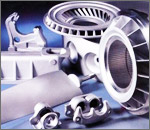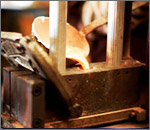Introduction: Permanent mold casting is the process in which the molds are made of metals like cast iron or steel. This casting technique is favored because mass production of castings

can be done in a single run, thus helping in reducing manufacturing expenditure. In addition, permanent mold casting, which is an inexpendable casting process, can be fully automated.
Process: In permanent mold casting molds are made of metals but the patterns can be made either of sand or metals. The molds are made using metals like cast iron or steel. These metal molds expand on heating or when hot metal is poured into it. Therefore, while making the mold, it is not expanded as is done with sand and plaster molds. But, care must be taken to maintain the thermal balance during the casting process.
Metals are poured over the patterns to shape them into the required mold shapes. Unlike sand and plaster molds, permanent molds are not flexible to all types of patterns. Once the mold is set, the pattern is drawn out to reveal the coarse mold cavity. These cavities are to be machined to be made smooth. Cavity is then coated with a layer of refractory materials like clay or sodium silicate that makes the mold cavity heat resistant, allows easy ejection of the casting and increases the life of the mold. Machined gates are then attached to the mold.
For casting, the mold is first preheated and molten metal poured into the cavity and solidified. Once the metal is set, it is removed from the mold and the permanent mold is closed again to repeat the casting process. The casts take a weeks time to solidify.
Types of Permanent Molds: Gravity Permanent Mold: It the flow of the metal into the mold using the force of gravity. Gravity pouring are of two types: static pouring where the molten metal is poured form the top and; tilted pouring where the mold is slanted and the metal is poured into the mold using a basin. Gravity permanent mold casting produces accurate casting than shell mold castings.
Low-Pressure permanent Mold: In this process only very little amount of forces is used to push the metal into the mold. Low-pressure permanent mold casting process enables producing uniform castings with excellent dimensional accuracy, perfect surface finish and superior mechanical properties.
Applications: Permanent mold casting process is used to cast products from iron, aluminum, magnesium, and copper based alloys. Typical permanent mold casting components include gears, splines, wheels, gear housings, pipe fittings, fuel injection housings, and automotive engine pistons, timing gears, impellers, compressors, pump parts, marine hardware, valve bodies, aircraft parts and missile components.
 Advantages:
Advantages:
- Suitable for high volume casting ceramic
- Quality of heavier casting improves with better use of tooling's and equipment
- Casted products have better tensile strength and elongation than sand castings
- Mass productions can be done is a single production run, which reduces the manufacturing cost
- Products have excellent mechanical properties.


